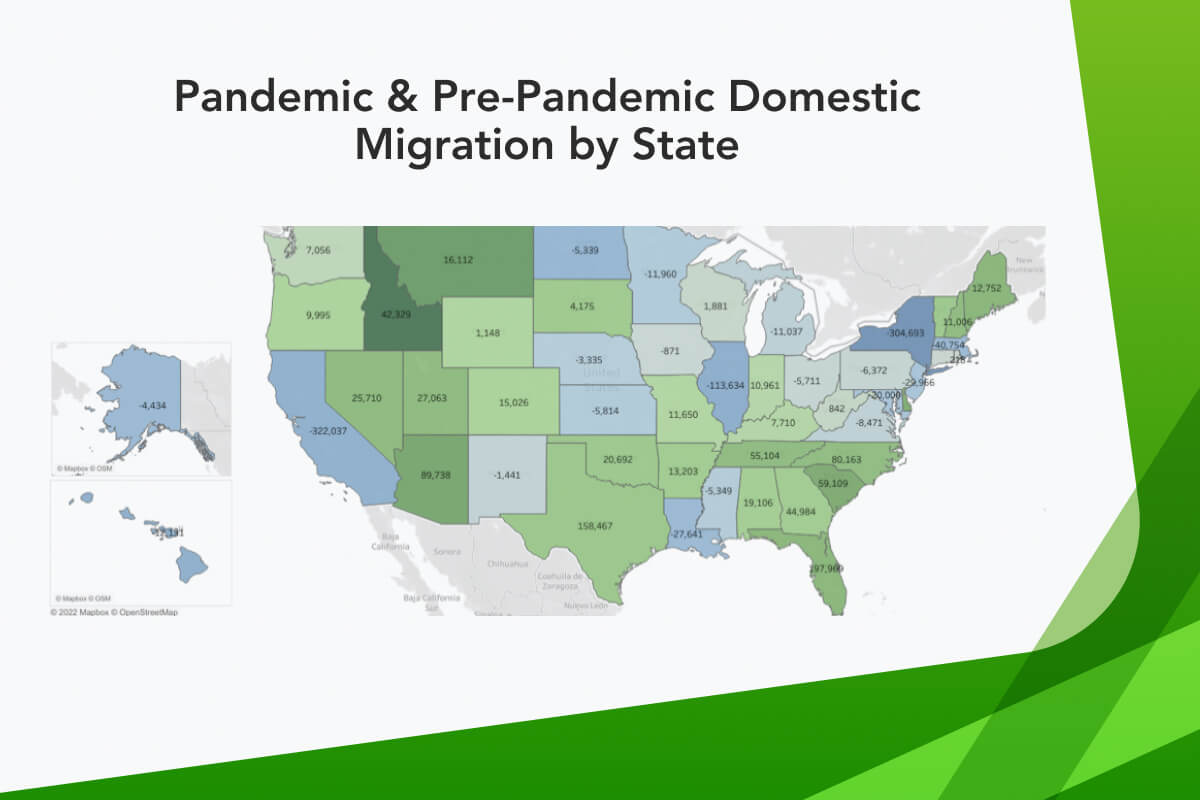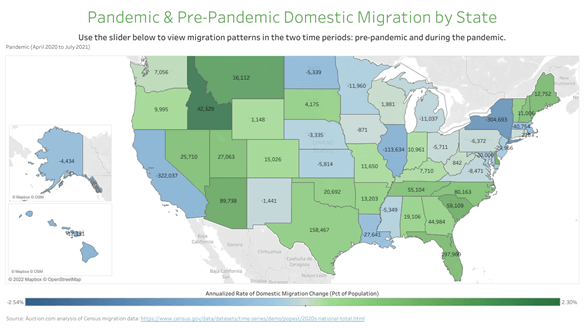
More Americans are moving to markets with less dense, lower cost housing. Local community developers are renovating distressed housing stock to help meet the increased demand in those markets.
The pandemic accelerated already existing domestic migration trends in most states — both positively and negatively — while reversing pre-pandemic migration trends in 10 states and the District of Columbia, according to an analysis of population migration data from the Census bureau.
Migration trends matter for housing because they are a leading indicator of increasing or decreasing housing demand, which could strengthen or weaken a state’s housing market. Migration trends are a key component supporting the real estate investing strategy for many local community developers who purchase distressed properties and then resell the renovated homes to owner-occupants.
“When we sold the last home, most of the folks coming to the property were millennials moving out of the city,” said Will Wenzel, an Auction.com buyer who works with a business partner to buy and renovate homes in the suburban Connecticut communities where they both grew up. Wenzel noted that he and his partner have another renovated home under contract with a millennial buyer who is moving out of New York City. “They’re saying I don’t want to live in the one-bedroom, one-bath apartment that’s 600 square feet with a one-year-old.”
Although he expects some of those who moved out of New York City during the pandemic to return as the pandemic subsides, Wenzel believes the millennial migration to the suburbs is driven by more than just the pandemic, and it’s a trend that will continue for the longer term.
“I think that will be a big driver of suburban housing for the next five years,” he said, noting that prior to the pandemic he and his partner developed an investment thesis predicated largely on a millennial migration to the suburbs. “That was our thesis going in, and we’re seeing signs of that playing out.”
Accelerating In-Migration
In the decade leading up to the pandemic, a clear domestic migration pattern had already been established: Americans were moving away from high-cost housing markets like New York, California and Illinois and moving to more affordable housing markets like Florida, Texas and Arizona. Between 2010 and 2020, Florida gained nearly 1.5 million people from domestic migration, meaning 1.5 million more Americans moved to Florida than moved out of Florida during that period. Florida’s nation-leading population gain from domestic migration was followed by Texas (1.3 million), Arizona (565,000), North Carolina (548,000), and South Carolina (422,000).
During the pandemic — between April 1, 2020, and July 1, 2021, using the latest Census data — those same five states led the country in population gains from domestic migration, and in the same order. Florida led the way with a gain of more than 263,000 followed by Texas (211,000), Arizona (119,000), North Carolina (106,000) and South Carolina (78,000).
The pace of domestic migration to all five of these states accelerated during the pandemic when looked at on an annualized, percentage gain basis. During the pandemic period covered by the Census data, Florida’s rate of annual domestic migration gain increased by 14 basis points, Texas by 3 basis points, Arizona by 37 basis points, North Carolina by 19 basis points and South Carolina by 24 basis points.
The annualized rate of domestic migration to Idaho increased the most of any state during the pandemic, up 138 basis points compared to the annual rate between 2010 and 2020. Idaho was followed by Montana (up 90 basis points), Maine (up 78 basis points), Vermont (up 71 basis points), New Hampshire (up 70 basis points) and Connecticut (up 55 basis points).
Renovating Relics
In the cases of Vermont and Connecticut, domestic migration reversed course during the pandemic, turning positive after running negative in the decade leading up to the pandemic. The shift in Connecticut was one Wenzel was counting on when he quit his day job to focus on real estate investing full time in February 2020.
“We realized we were at the beginning of a great suburbanization where the millennial generation is moving to the suburbs,” he said, adding that another key part of his investment thesis was the outdated nature of much of the suburban housing stock. Case in point is his most recent renovated resale, a Weston, Connecticut, home originally built in 1965 that he purchased at an online bank-owned (REO) auction on Auction.com. “After we won the property was when we first saw it (inside). …We just really noticed that this was a relic of the past. This was created for a bygone area.”
Wenzel sold the property to an owner-occupant after a substantial design and renovation process that lasted 10 months and warranted the property being classified as new construction on the resale listing.
“It’s modern, it’s exceptional, it’s got all the features that people want,” said Wenzel, whose investing partner is a licensed general contractor and designer. “What I find most rewarding about this process is creating the future. With these homes and this process, we’re able to take what this current generation will want and give it to them.”

Accelerating Out-Migration
Wenzel’s bet that, even without the pandemic, many millennials would be migrating out of places like New York City, where housing is dense and expensive, is supported by the Census migration data. The state of New York lost nearly 1.6 million people to domestic migration in the decade leading up to the pandemic. The state lost 0.82 percent of its population to domestic migration per year on average during that period. That trend accelerated during the pandemic, when New York lost 1.51 percent of its population to domestic migration on an annualized basis between April 1, 2020, and July 1, 2021.
California lost nearly 1.2 million people to domestic migration between 2010 and 2020, the second most of any state after New York. Illinois lost 978,000 people to domestic migration during the decade, the third highest of any state. Out-migration trends accelerated during the pandemic for all three states, with the annualized rate increasing by 69 basis points in New York, 50 basis points in California and 12 basis points in Illinois.
Reversing Migration Trends
Vermont and Connecticut were two of nine states where domestic migration trends turned positive during the pandemic after running negative in the decade prior. Other states in this camp were Rhode Island, Wyoming, West Virginia, Missouri, Indiana, Kentucky and Wisconsin.
On the other end of the spectrum were North Dakota and the District of Columbia. In both cases, domestic migration added to the total population between 2010 and 2020 but subtracted from the total population during the pandemic. And in both cases, the reversal was quite dramatic. North Dakota went from gaining an average of 3,200 people per year from domestic migration between 2010 and 2020 to losing more than 5,300 people on an annualized basis during the pandemic. Domestic migration added about 2,600 people per year to the population of DC in the decade leading up to the pandemic but subtracted more than 17,000 people on an annualized basis during the pandemic.

